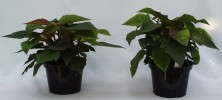Selecting Fertilizer Formulations To Manage Plant Growth

Growers have several tools at their disposal to manage the finished height of crops — from negative DIF to plant growth regulator applications. Certainly, the rate of fertilizer application — like 150 versus 250 ppm nitrogen (N) — influences plant growth rate and size. But beyond this, an often overlooked strategy of growth management is in the selection of the fertilizer formulations used to provide plant nutrients.
The formulation is presented on a bag of fertilizer as percent N to percent phosphorus (P2O5) to percent potassium (K2O). The specific nutrients to evaluate when your focus is growth management are phosphorus and nitrogen.
Restricting (but not eliminating) phosphorus in the fertilizer source is a great growth management tool. Phosphorus availability often limits plant growth in nature, and phosphorus deficiency can be used to stall growth and stretch. In fact, the first visual indication of phosphorus deficiency is smaller, darker-green foliage. More phosphorus translates to larger, lusher growth.
Nitrogen is the only essential nutrient that is absorbed by plants as both a cation and an anion. The cation form is ammonium (NH4+) and the anion form is nitrate (NO3ˉ). You have to study the label on the fertilizer bag to determine the percent of each form. Plants generally grow largest when both forms are provided.
The ammonium to nitrate ratio in the fertilizer may have some effect on plant architecture of some species: the more ammonium provided to the crop, the lusher the foliage and the weaker the stems tend to be. Fertilizer formulations with high concentrations of ammoniacal nitrogen include 20-10-20 and 15-16-17. On the other hand, the more nitrate provided to the crop, the shorter the internodes and more compact plant growth tends to be. Fertilizers with a high amount of nitrate include 13-2-13 and 15-0-15.
But plant responses to the nitrogen form in fertilizer formulations is confounded by the fact that phosphorus is often added to fertilizer as ammonium phosphate — so when ammoniacal nitrogen is high, phosphorus is also usually high. Research at North Carolina State University on plugs by Paul Nelson’s group has shown that it’s really the phosphorus, not the ammoniacal nitrogen, that contributes to plug stretch.
But ammonium phosphate is a useful growth management tool. Figure 1 shows research done with poinsettias from P. Allen Hammer’s research group at Purdue University: nitrate fertilizer was applied continuously to the plant on the left versus fertilizer with higher ammoniacal nitrogen and phosphorus applied until the beginning of short days to the plant on the right. The same nitrogen rate was applied in both cases.
At flowering, both the poinsettia cultivars ‘Prestige Red’ and ‘Premium Red’ were larger if they had received more ammoniacal nitrogen and phosphorus earlier in the cropping cycle.
So if you’re looking to push plant growth, look for fertilizer formulations with plenty of ammonium phosphate — within limits. It’s always a good idea to keep the amount of ammonium in your fertilizer below 40 percent to avoid ammonium toxicity. So now you know the secret to those “miraculous grow” fertilizer formulations — lots of phosphorous and ammoniacal nitrogen pushes plant growth.
GG










